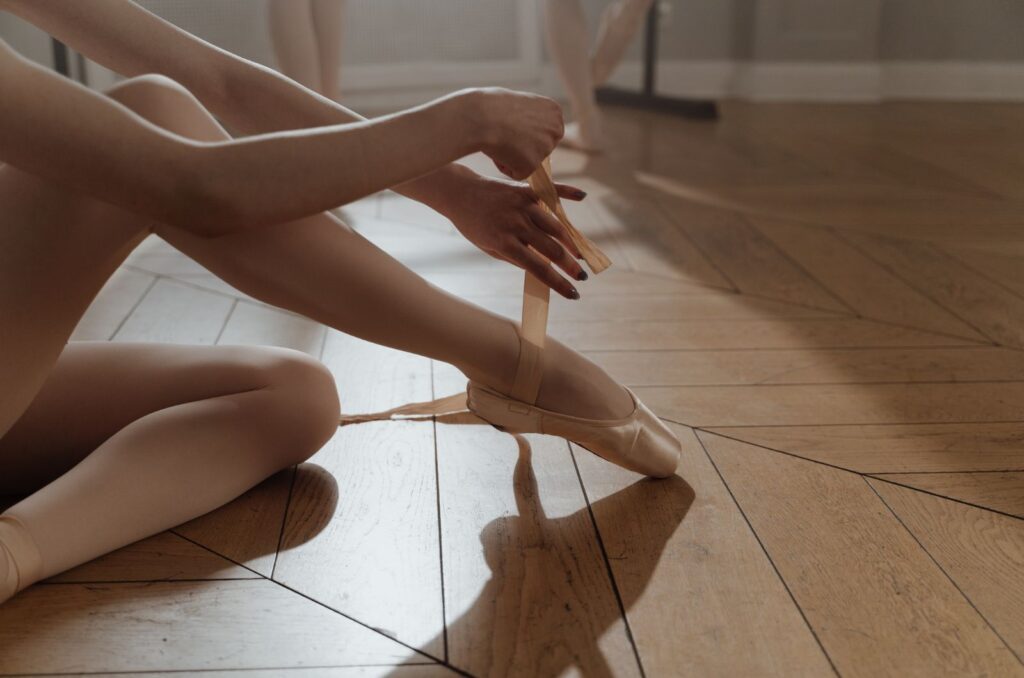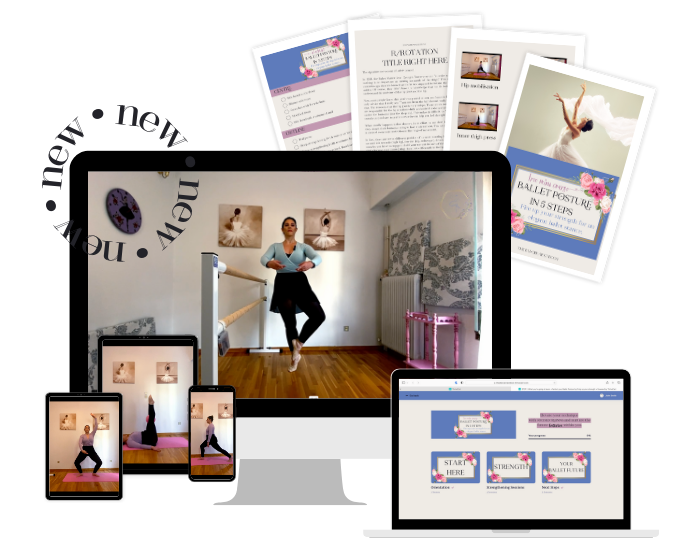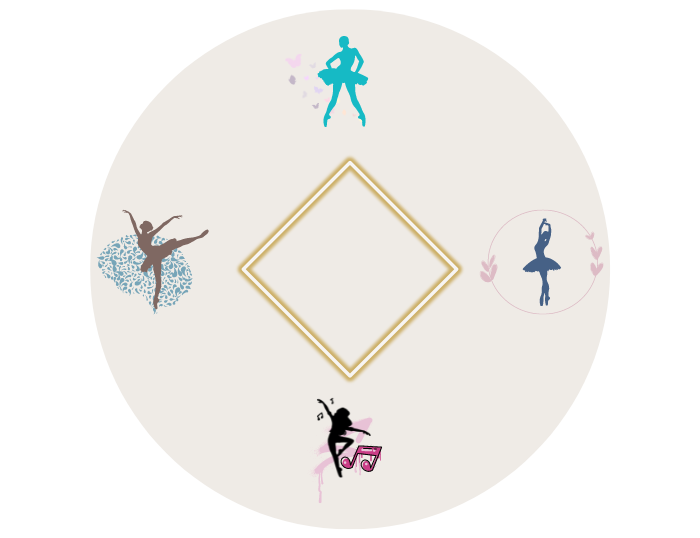As an adult ballet learner, you’re no stranger to the magic of ballet. What probably drew you to ballet in the first place is the grace and the beauty of it. Once you took your first ballet class, you probably felt incredibly rewarded by the feeling of your muscles in your body, the challenge ballet presents to your brain and all the new knowledge you acquired. But have you ever considered the profound impact it can have on your mental well-being? There’s an incredible connection between ballet and mental health.
Today, I invite you to explore the captivating world of the mind-body connection in ballet and discover how dancing can benefit your mind as well as your body.
Ballet is quite unique for several reasons: it combines the art of music and the physical movement. Both of those things bring a unique set of benefits for your body and mind, but ballet combines both. Of course, other styles of dance also combine these, but ballet has an extra couple of tricks up its sleeve. First of all, studies show that classical music has a positive impact on the brain. So, it’s not just the benefits of music in general, but classical music.
On top of this, ballet’s uniqueness lies not only in its combination of music and movement but also in its incorporation of the art of illusion. Fir instance, ballet positions and movements are meticulously designed to create illusions, crafting lines that are not just physically engaging but visually captivating. Here, a ballet dancer embodies the role of a musician, an athlete, and a magician.
How cool is that?

Understanding why ballet and mental health are connected
The allure of ballet extends beyond the aesthetic, tapping into the intricate dance of neural synchrony within the human brain.
The ballet world is a special mix of art and exercise. You know that good feeling you get when your muscles are working during a ballet class? Well, there’s more to it! The Synchronicity Hypothesis of Dance says that when you dance, your brain is doing a special dance too. It’s not just about looking good; it’s about making your brain and body work together in a unique way.
Furthermore, ballet is not just about graceful moves. The way your brain’s rhythmic dance matches up with the rhythm of life is pretty awesome. It’s like your brain and body team up, creating a dance that’s as complex and organised as the natural world. Remember how babies move to music and it makes them happy? Ballet does the same thing for adults—it brings joy by making your brain and body groove together.
Additionally, The Synchronicity Hypothesis looks at different parts of dance, like how it might have evolved to help people work together or the basic moves that show up in dances all around the world. It’s like a puzzle made up of how your senses, muscles, thoughts, feelings, and creativity all play together. This puzzle, when put together, helps your brain do a synchronised dance.
This way of looking at dance suggests that when you dance, your brain is rewarded, and this reward helps people connect better with each other. It’s like dance has a superpower to reshape how your brain works.
When you’re dancing, you’re part of a special choreography where your brain and body sync up. It’s like a shared experience that goes beyond the studio.
The Physical and Mental Health Benefits of Ballet
Now, let’s explore the specific physical and mental health benefits of ballet. Further, you’ll find out how you can enjoy ballet not just a pleasant activity but as a way to improve your life.
A. Physical benefits of ballet
1. Improved body awareness and posture:
Moving through a barre exercise or a full variation brings body awareness and increases your proprioception in a way that other physical activities don’t.
Proprioception
Proprioception, or kinesthesia, is the sense that lets us perceive the location, movement, and action of parts of the body. It encompasses a complex of sensations, including perception of joint position and movement, muscle force, and effort.
That’s because ballet is very detailed, making you think about every tiny part of your body – literally from head to toe. At the same time it teaches you to move through space and in close proximity with other people.
That’s why that posture and grace is transformed throughout your life even outside the ballet studio.
2. Release of endorphins and reduction of stress:
When you dance, endorphins flood your brain, lifting your spirits and washing away stress.
Endorphins are natural chemicals produced by the body that act as neurotransmitters, transmitting signals in the brain. Often referred to as “feel-good” hormones, endorphins are released during activities such as exercise, laughter, or moments of joy, contributing to a sense of well-being and happiness.
3. Enhanced physical fitness and flexibility
Ballet is a rigorous and dynamic art form that strengthens your body from head to toe. Consequently, your muscles become more toned, your endurance increases, and your flexibility improves, even when you’re not actively stretching.

B. Emotional benefits of ballet
1. Boosted self-confidence and self-esteem:
As you master challenging ballet techniques and see your progress unfold, you’ll discover a newfound confidence and belief in your abilities.
Now, for this to work, you need to be in the right environment among supportive teachers and classmates.
Especially, it’s important to dance with teachers who are truly rooting for you and believe in adults learning and progressing in ballet.
🚨 Unfortunately, the ballet world is notorious for creating quite the opposite: low self-esteem, negative body image, imposter syndrome due to elitist background and old-fashioned approach to teaching through ‘tough love’.
There are many reasons why these harmful tactics still exist in the ballet world, a very important one being that there are a lot of non-teachers, with minimal to zero understanding of teaching methods who perpetuate the trauma they endured as young ballet students.
However, ballet has the potential to work wonders for your self-esteem, given that you’re surrounded by the right people.
2. Increased ability to manage and express emotions:
Ballet provides a safe and expressive outlet for your emotions, allowing you to release, explore, and communicate feelings that words may fail to capture. Dance your heart out and let your emotions flow freely!
3. Alleviation of symptoms related to anxiety and depression:
The rhythm, discipline, and sheer joy of ballet have been shown to reduce symptoms of anxiety and depression. Allow ballet to lift your spirits and bring a sense of serenity and happiness to your soul.
C. Cognitive benefits of ballet
1. Improved focus, concentration, and mental agility:
Ballet demands unwavering focus and disciplined concentration. As you bring your mind into harmony with your body, you’ll experience sharper cognitive skills, enhanced memory, and increased mental agility, both inside and outside the dance studio.
2. Enhanced memory and brain function:
The intricate sequences and patterns of ballet choreography challenge your memory, fortifying the neural connections in your brain.
3. Increased creativity and artistic expression:
Let’s not forget that the most important part of ballet is the fact that it’s an art form. As a ballet student, you are an artist, able to do what artists do. Create, express, inspire, beyond words. Ideally, ballet should encourage you to express your unique artistic voice, fostering a boundless imagination and inspiring moments of pure artistic delight.
Unleash your inner ballerina and let your creativity soar!

Incorporating Ballet into Your Daily Life
Feeling inspired? Wondering how to make ballet an integral part of your mental health routine? I have some practical tips to help you embrace ballet in your daily life and experience its transformative effects firsthand.
A. Practical Tips for Ballet Integration
1. Find the right ballet class:
Seek out a class that aligns with your schedule and ballet, whether it’s a local or an online studio or a combination of both. Make sure that the studio embraces adults in the ballet world.
2. Dedicate time to dance:
Set aside specific time in your daily schedule for dance. Even a few minutes of practice can make a world of difference. Remember, consistency is key!
3. Create an inspiring space:
Designate a tranquil space where you can dance freely. Surround yourself with items that bring you joy and immerse yourself in the enchanting world of ballet. However, said space doesn’t have to be big, it can just be your special little corner.
4. Embrace authenticity:
Let go of perfectionism and embrace the joy of movement. Dance by being true to who you are, celebrating the beauty of your unique dance journey.
B. Explore Ballet Resources:
1. Local ballet studios:
Seek out local ballet studios or community groups offering classes designed specifically for adults. Connect with fellow ballet learners and revel in the joy of shared experiences.
2. Online courses and classes:
Explore a variety of online courses and classes that cater to all skill levels.
You can start with my free mini course ‘Ballet Posture in 5 steps’ designed to bring the joy of ballet directly to you. Embrace the flexibility of learning at home and at your own pace.
Learning ballet as an adult is a wonderful way to improve your physical and mental health. Click here to find out more useful tips about making that process easier and more fulfilling.
Embrace Ballet's Transformative Powers
In the world of ballet, the beauty extends beyond graceful movements—it’s a dance of mind and body.
More than a physical exercise, ballet, as revealed by the Synchronicity Hypothesis, is a joyful experience for your brain. It mirrors the rhythmic dance of life, bringing happiness and a profound connection between your brain and body.
Ballet’s benefits go beyond the studio, shaping physical and mental well-being. Notably, from improved posture to the release of stress-relieving endorphins, ballet becomes a sanctuary for self-expression, boosting confidence and managing emotions.
Cognitively, ballet enhances focus and mental agility, refining memory through intricate choreography. As a ballet student, you’re not just a dancer—you’re an artist, expressing a unique voice beyond words.
As you revel in the joy of ballet, remember to integrate it into your daily life. Ignite your inner dancer, and let the transformative powers of ballet enrich your life beyond the dance studio.






